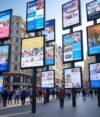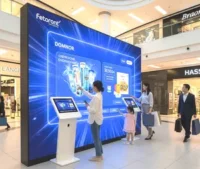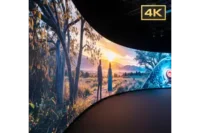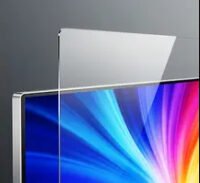Architectural LED Integration: Revolutionizing Building Facades and Curtain Walls with Modern Design Aesthetic
Published: 19 May 2025
In the ever-evolving world of architecture, Architectural LED Integration has emerged as a game-changer. By seamlessly blending technology with design, LEDs are transforming building facades, curtain walls, and the very essence of LED design aesthetics. This 3000+ word guide dives deep into how LEDs are redefining urban landscapes, offering energy efficiency, visual dynamism, and unparalleled creativity.

The Rise of Architectural LED Integration 🚀
What Is Architectural LED Integration?
Architectural LED integration means that strategic inclusion of LED light systems in structural structures increase both functionality and visual appeal. Unlike traditional lighting, LEDs provide flexibility, stability and dynamic controls, making them ideal for modern architectural projects.
Development from traditional lighting to LED
• Early days: Limited by high energy consumption and static designs, incandescent lights and fluorescent lamps dominated.To know about “outdoor led screen” click here 📺
• LED revolution: With low energy consumption, long -lasting life and adaptable functions, LEDs became the cornerstone of Smart Architecture.
• Current trends: IoT, integration with adaptive lighting and interactive fake.
Why are the architects embraced?
• Stability: 60-70% energy savings compared to traditional systems.
• Design freedom: Thin profiles, RGB color options and programmable sequences.
• Durability: Resistant to vibration, temperature change and weather conditions.
Building Facades: Where Light Meets Structure 🏢💡
To increase visual identity with LED
LED -converted static face to dynamic canvas. Examples include:
• Branding: Business logo animated with rolling LED pattern.
• Cultural expression: Historical buildings informed to highlight the architectural details.
• Designed design: Festive lighting for holidays or public functions.
Case study: Burj Khalifa, Dubai 🌆
Burj Khalifa’s LED-Lits Mask Mesming Prakash Show for events such as New Year’s Eve, which combines cultural motifs with state of the art technology.
Technical idea for mask integration 🔧
• Heat control: Ensure proper ventilation to prevent overheating.
• Weather resistant: IP65+ ranked LED for rain, air and dust resistance.
• Pollution control lighting: Directive lighting to reduce the skull.
Curtain walls: fusion structure and light 🏗 🏗
What are the LED-covered curtain walls?
Curtain walls are non-structural exterior cover made of glass, metal or stone. Integration of LEDs into these systems makes shining, energy – efficient external.
The benefits of LED curtain walls 🌟
• Energy efficiency: LED pairs with solar panels for buildings online.
• Adaptive transparency: glass panels with built -in LEDs that adjust ambiguity based on sunlight.
• Aesthetic versatility: to make patterns, gradients or even video shows.
Example: Age, Amsterdam 🏙
This smart office uses LED-located curtain walls to show data on real-time energy use, merging tools with art.
Installation challenges ⚠
• Weight distribution: Ensure structural support for additional LED components.
• Cabling complexity: Hides cables within the wall profile of the slim curtain.
• Use of maintenance: Panel design for easy LED replacement.To increase visual identity with LED
LED -converted static face to dynamic canvas. Examples include:
• Branding: Business logo animated with rolling LED pattern.
• Cultural expression: Historical buildings informed to highlight the architectural details.
• Designed design: Festive lighting for holidays or public functions.
Case study: Burj Khalifa, Dubai 🌆
Burj Khalifa’s LED-Lits Mask Mesming Prakash Show for events such as New Year’s Eve, which combines cultural motifs with state-of-the-art technology.
Technical idea for mask integration 🔧
• Heat control: Ensure proper ventilation to prevent overheating.
• Weather resistant: IP65+ ranked LED for rain, air and dust resistance.
• Pollution control lighting: Directive lighting to reduce the skull.
Curtain walls: fusion structure and light 🏗 🏗
What are the LED-covered curtain walls?
Curtain walls are non-structural exterior cover made of glass, metal or stone. Integration of LEDs into these systems makes shining, energy -efficient external.
The benefits of LED curtain walls 🌟
• Energy efficiency: LED pairs with solar panels for buildings online.
• Adaptive transparency: glass panels with built -in LEDs that adjust ambiguity based on sunlight.
• Aesthetic versatility: to make patterns, gradients or even video shows.
Example: Age, Amsterdam 🏙
This smart office uses LED-located curtain walls to show data on real-time energy use, merging tools with art.
Installation challenges ⚠
• Weight distribution: Ensure structural support for additional LED components.
• Cabling complexity: Hides cables within the wall profile of the slim curtain.
• Use of maintenance: Panel design for easy LED replacement.
LED Design Aesthetics: Crafting Visual Masterpieces 🎨🔮
Lighting in architecture
LEDs allow architects to manipulate light by outstanding methods:
• Color psychology: Use warm/cool tones to provoke emotions.
• Dynamic lighting: Programs that change hue with time or user interaction.
• Minimum design: Smooth, hidden LEDs that emphasize clean lines.
Trend in LED aesthetics 🌈
• Biophilic design: imitation of natural light cycles to increase welfare.
• Interactive faces: Movement sensors that respond to pedestrians.
• 3D effects: layered LEDs form depth and texture.
Case Study: Vivid Sydney Festival 🎪
Recognized structures such as the Sydney Opera House become canvas for LED estimates, conclusion art, technology and architecture.
The benefits of architectural LED integration 🌟
1. Energy efficiency and cost savings 💰
• LEDs use 80% less energy than traditional bulbs.
• Long life (50,000+ hours) reduces the cost of maintenance.
2. Stability ♻
• Audit materials and low -carbon footprints.
• Compatibility with renewable energy systems.
3. Increased security and functionality 🛡
• Emergency light integration for clearance routes.
• Adaptive lighting for better visibility in public places.
4. Branding and community engagement 🤝
• Customized business identity or public art.
• Night events that promote local tourism and economy.
Challenges and thoughts ⚠
1. Establishment complexity 🛠
• Collaboration between architects, electricians and engineers is required.
• To retrofit chronic buildings may require structural upgrading.
2. Regulatory compliance 📜
• After local light pollution and energy code.
• Secure Ada -Sami for public places.
3. Maintenance and upwards 🔄
• Dust and pollution can reduce shiny glow over time.
• Use of challenges in high growth buildings.
4. Starting cost 💸
• High advance investments for Premium LED systems.
Future trends in LED employee architecture 🔮
1. Smart building integration 🧠
• AI-driven light that is beneficial for coating and weather.
• Synchronize with smart urban network for energy optimization.
2. Permanent innovation 🌱
• Solar -powered LED and biodegradable materials.
• Harvesting kinetic energy from bone traffic.
3. Promoted reality (AR) Overlay 🕶
• AR apps that interact with LED facades for immersive experiences.
4. Self -healing LED 🔧
• Materials that repair minor cracks or color drops.
Conclusions:
To bring the path forward for tomorrow’s architecture
Architectural LED integration exceeds a trend – this is a paradigm shift. By establishing reconciliation in the aspects of the building, curtain walls and LED design aesthetics, architects can create places that are durable, functional and visually fantastic. As technology develops, the fusion of light and structure will continue to redefine the urban skyline.
Questions about architecturally led integration ❓
1. How do LED buildings improve energy efficiency?
LEDs use low power, generate minimum heat and live longer than traditional bulbs, reduce energy and replacement costs.
2. Can LED systems be retrofitted in older buildings?
Yes, but structural assessment and customized solution may be necessary to handle wires and weight.
3. Does LED employees suffer from light pollution?
Modern design uses prescription fixtures and smart controls, which accurately conduct split.
4. What is the average life of architectural LEDs?
High quality LED equals 10+ years of typical use, the last 50,000-100,000 hours.
5. How are customized designs for facades?
Extremely! From static colors to animated videos provide LEDs endless creative possibilities.

- Be Respectful
- Stay Relevant
- Stay Positive
- True Feedback
- Encourage Discussion
- Avoid Spamming
- No Fake News
- Don't Copy-Paste
- No Personal Attacks



- Be Respectful
- Stay Relevant
- Stay Positive
- True Feedback
- Encourage Discussion
- Avoid Spamming
- No Fake News
- Don't Copy-Paste
- No Personal Attacks





